Welcome to the exciting world of smart home automation! If you’ve ever dreamed of a home that anticipates your needs, saves you energy, and offers unparalleled convenience, then you’re in the right place. This comprehensive smart home automation guide is designed specifically for beginners, helping you navigate the fundamentals of making your living space smarter and more efficient. Gone are the days when smart homes were a futuristic fantasy; today, they are an accessible reality, offering tangible benefits that improve daily life.
The global smart home market size, valued at an impressive USD 121.59 billion in 2024, is on a remarkable trajectory, projected to reach USD 633.20 billion by 2032, showcasing a compound annual growth rate (CAGR) of 23.1% from 2025–2032. [3, 8] This incredible growth highlights the increasing adoption and transformative potential of smart technology in our homes. In fact, as of September 2023, approximately 42% of households across the U.S. had embraced at least one form of smart home device, demonstrating a clear shift towards connected living. [5, 17]
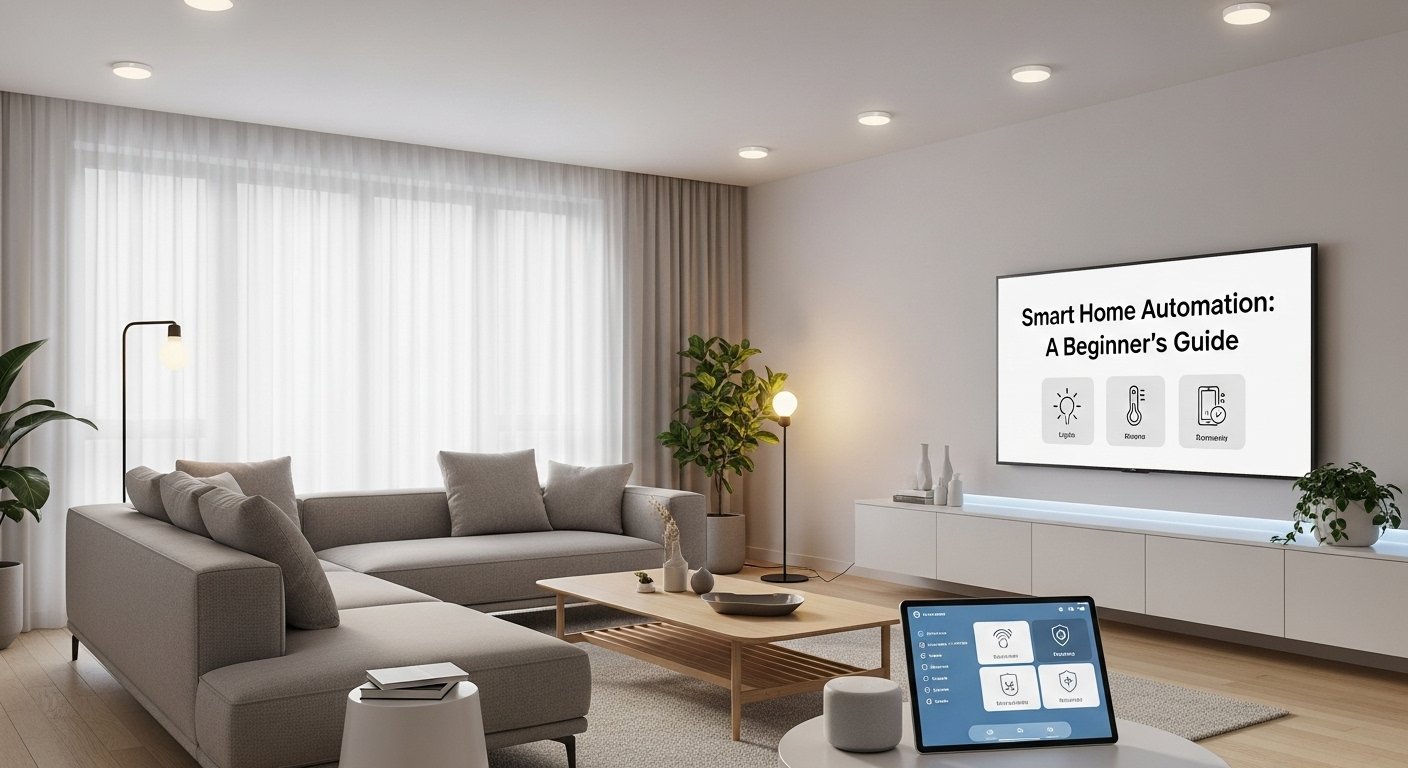
What is a Smart Home? Understanding Home Automation Basics
A smart home is a residence equipped with devices that can connect to a network, often the internet, and communicate with each other, as well as with you. This interconnectedness allows for the remote monitoring, control, and automation of various household functions. Think of it as giving your home a ‘brain’ that can learn, adapt, and respond to your preferences and external conditions. Essentially, what is home automation? It’s the process of making your home’s systems and devices work together, either automatically or through simple commands, to enhance comfort, security, and efficiency. [35]
What Do Smart Homes Do?
Smart homes can perform a vast array of functions, making everyday tasks simpler and more intuitive. They can:
- Automate lighting: Turn lights on/off, dim, or change color based on schedules, motion, or daylight.
- Regulate temperature: Smart Thermostats learn your preferences and adjust heating/cooling for optimal comfort and energy savings.
- Enhance security: Monitor your home with smart cameras, doorbells, and locks, often with remote access.
- Manage energy: Track energy consumption and optimize device usage to reduce utility bills.
- Provide entertainment: Integrate with smart speakers and TVs for seamless media control.
- Assist with daily routines: Set up automation routines for morning alarms, bedtime, or ‘away’ modes.
In essence, smart home automation transforms your living space into an intelligent environment, responsive to your lifestyle and capable of making your life easier and more comfortable. It’s about bringing convenience, efficiency, and peace of mind right to your fingertips, or even to the sound of your voice.
Why Embrace Smart Home Automation? Benefits for Beginners
For those just getting started with home automation, the benefits are numerous and immediate. It’s not just about cool gadgets; it’s about practical solutions that significantly improve your quality of life. The data supports this: a remarkable 77% of consumers report that their smart home devices have positively impacted their lives. [12]
Here are some key advantages of diving into the world of smart homes, highlighting the smart home benefits for beginners:
- Unmatched Convenience: Control lights, thermostats, and appliances from your smartphone or with simple voice commands, whether you’re home or away. No more fumbling for light switches or worrying if you left the oven on.
- Enhanced Security: Keep an eye on your home with smart security cameras and receive instant alerts for unusual activity. Smart locks add an extra layer of protection, allowing you to grant access remotely.
- Significant Energy Savings: Smart Thermostats and Smart Lighting systems optimize energy usage, reducing your carbon footprint and lowering utility bills. For example, a smart thermostat can learn your schedule and adjust temperatures when you’s not home, preventing wasted energy.
- Increased Comfort and Ambiance: Adjust lighting, temperature, and even music to create the perfect atmosphere for any occasion, all with a few taps or a voice command. Think about coming home to a perfectly lit, warm house after a long day.
- Property Value Boost: Installing smart devices in a home can even increase its resale value by up to 5%, making it a smart investment for the future. [1, 4, 17]
- Peace of Mind: Whether it’s checking on pets, ensuring doors are locked, or receiving alerts about potential issues, smart home technology provides a constant sense of security and control, even when you’re away. [36]
These benefits make smart home for beginners an incredibly appealing prospect, offering a blend of modern living and practical advantages.
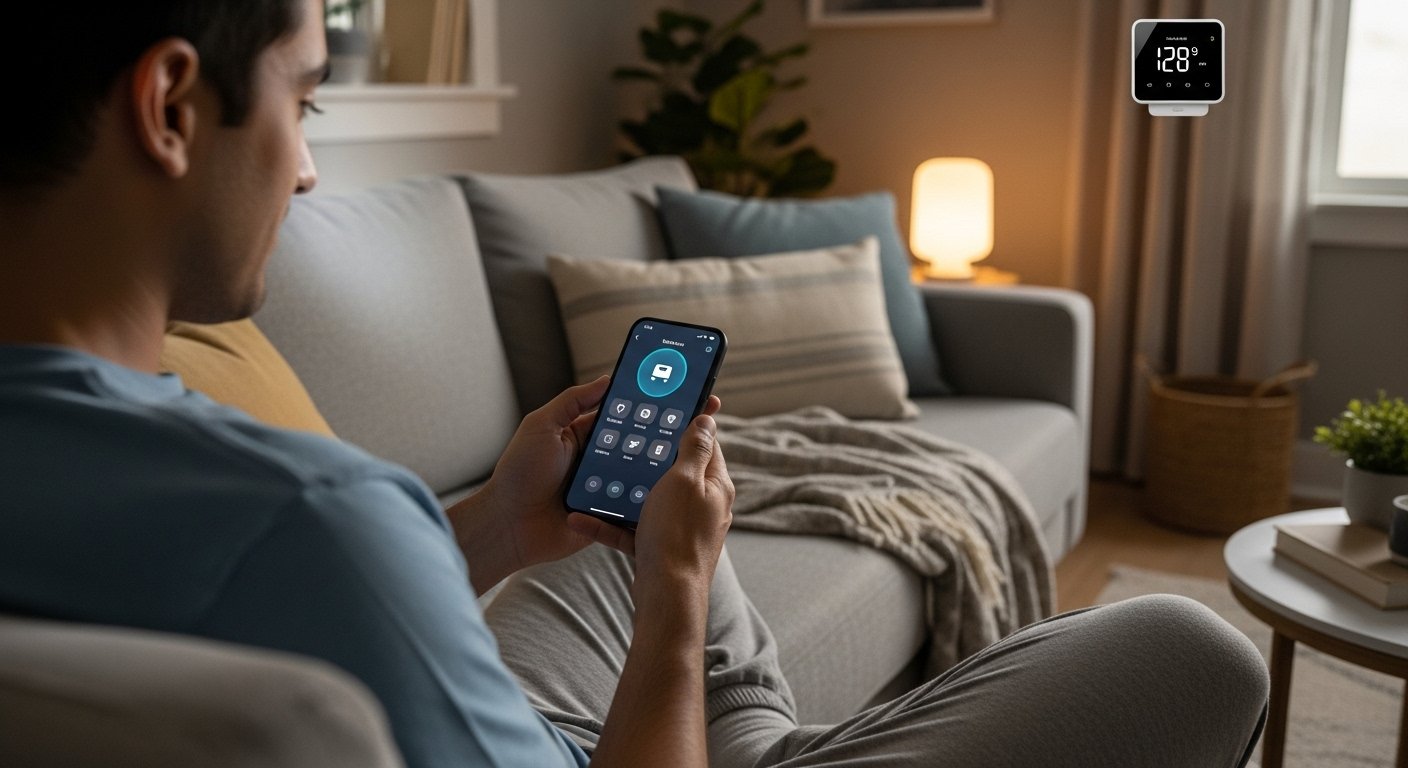
Your Smart Home Automation Guide: Getting Started with Your First Steps
Embarking on your smart home journey doesn’t have to be overwhelming. The key to how to set up smart home systems successfully is to start simple and expand gradually. Think of it as building your ideal home, one smart brick at a time.
Assess Your Needs and Priorities
Before purchasing any devices, take a moment to consider what you want your smart home to achieve. What are your biggest pain points or areas where you desire more convenience?
Here are a few common areas to consider, which align with popular smart home automation ideas:
- Energy Management: Are you keen on reducing your electricity bills? Smart Thermostats and Smart Plugs are great starting points.
- Security: Do you want to monitor your home, especially when you’re away? Smart cameras, doorbells, and locks can provide peace of mind.
- Convenience & Comfort: Do you want to easily control your lights or entertainment? Smart Lighting and Voice Assistants are excellent choices.
- Accessibility: Do you need solutions for easier control for family members with specific needs?
By identifying your priorities, you can focus on affordable smart home solutions that directly address your needs, avoiding unnecessary purchases.

Choosing Your Smart Home Ecosystem Explained
One of the most crucial decisions for smart home for beginners is selecting a primary ecosystem. This refers to the platform that will serve as the central control point for your devices. The three dominant players are:
- Amazon Alexa Ecosystem: Powered by Voice Assistants like Alexa, this ecosystem is known for its wide range of compatible devices, extensive third-party integrations, and popular Echo smart speakers. It’s an excellent choice for those who want broad device compatibility and robust voice control.
- Google Home Ecosystem: Centered around Google Assistant, this ecosystem integrates seamlessly with Google services (like Google Calendar, YouTube) and Android devices. Google’s Nest Hubs offer excellent smart display capabilities. It’s a strong contender for users already invested in the Google ecosystem.
- Apple HomeKit Ecosystem: For Apple users, HomeKit offers tight integration with iOS, iPadOS, and macOS devices, ensuring a highly secure and private experience. Devices compatible with HomeKit are often held to higher security standards. Siri serves as the voice assistant.
While devices are increasingly cross-compatible, choosing a primary ecosystem simplifies management and ensures smoother interactions between your devices. Many devices are compatible with multiple ecosystems, offering flexibility.
Starting Small: Essential Smart Home Devices for Beginners
Don’t try to automate your entire home overnight. Start with a few key devices that offer immediate value and expand as you become more comfortable. Here are some of the best smart home devices for beginners and common smart home devices for beginners that offer an excellent entry point, helping you understand what are smart home devices truly capable of:
- Smart Lighting: These are perhaps the easiest and most impactful entry point. Smart Lighting bulbs can be controlled via an app or voice, allowing you to turn lights on/off, dim them, or even change colors. Brands like Philips Hue and LIFX are popular. This is perfect for smart lighting automation to set moods or save energy. [37]
- Smart Plugs: These ingenious devices turn any regular appliance into a ‘smart’ one. Plug a lamp, coffee maker, or fan into a Smart Plug, and you can control it remotely via an app or voice assistant. They are incredibly versatile and an affordable smart home solution.
- Smart Thermostats: Devices like Google Nest or Ecobee can learn your schedule, save energy, and be controlled from anywhere. They are fantastic for smart thermostat installation and offer significant long-term savings and comfort. [31]
- Smart Speakers & Voice Assistants (Alexa, Google Assistant, Siri): Essential for voice control, Smart Speakers like Amazon Echo, Google Nest Audio, or Apple HomePod mini act as your central command center. With smart home voice control setup, you can simply speak commands to control your devices, get information, play music, and much more. Smart Speakers are widely adopted, with many reports indicating high penetration. For example, by 2022, approximately 35% of the U.S. population aged 12 and above possessed a smart speaker, indicating widespread adoption. [11]
- Smart Home Security Basics: For initial security, consider a simple smart camera for monitoring or a video doorbell. These can provide essential insights into your home’s activity and are excellent entry points into the broader world of smart home security. Learn more about simple home automation for beginners here: Home Automation for Beginners: Smart Steps.
Starting with these foundational devices allows you to experience the benefits firsthand and understand what smart home devices are truly capable of, without a steep learning curve.
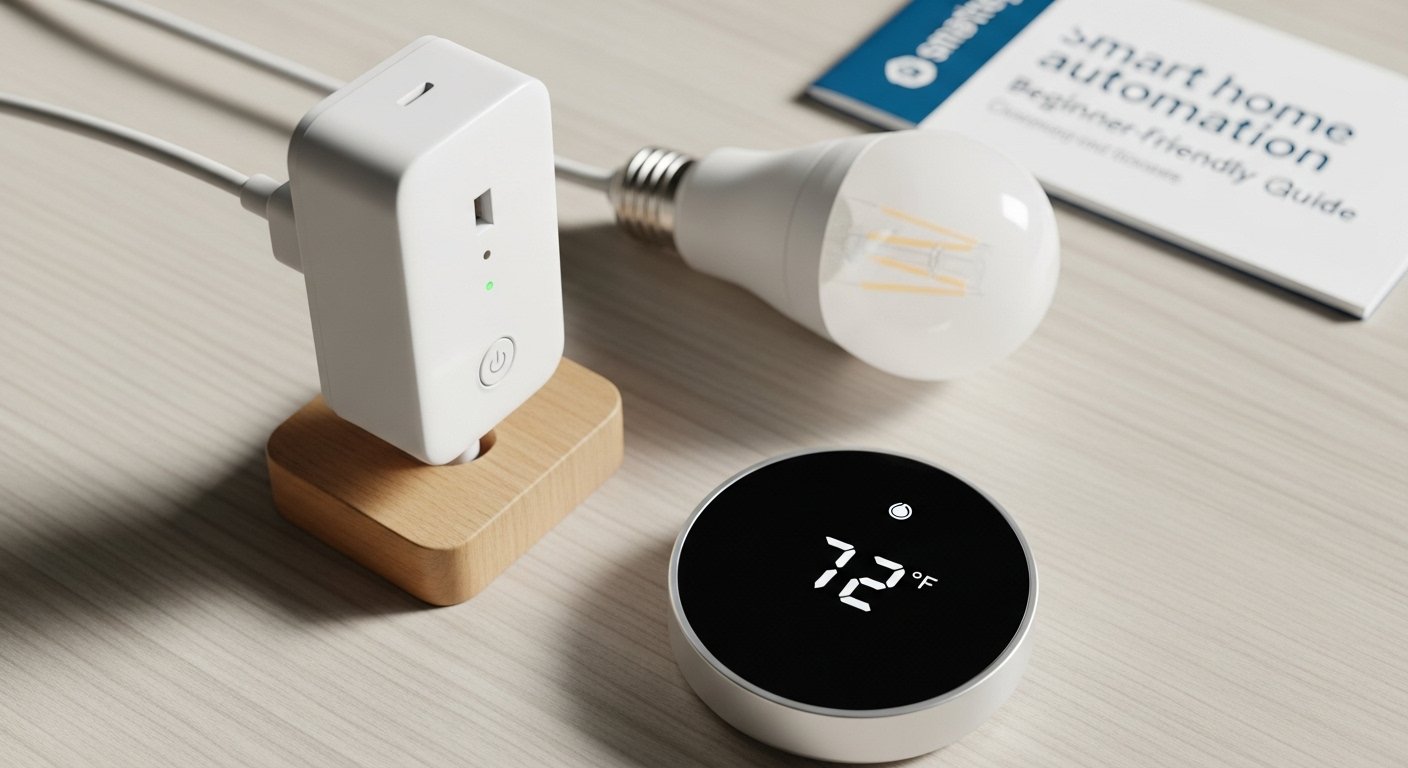
The Brains of Your Home: Smart Hubs and Communication
While many smart devices can operate independently, a Smart Hub often acts as the central brain of your smart home ecosystem explained. It allows devices from different brands or using different communication protocols to work together seamlessly. Understanding the role of a hub is crucial when considering how to make your home smart.
Understanding Smart Hubs
A Smart Hub serves several important functions, making it a strong contender for the best smart home hub:
- Centralized Control: It provides a single point of control for all your connected devices, often through a dedicated app.
- Enhanced Compatibility: Hubs can bridge the communication gap between devices using different wireless protocols.
- Local Processing: Some hubs allow for local processing of automation routines, meaning they can function even if your internet goes down.
- Advanced Automation: They enable more complex automation routines and scenes by orchestrating interactions between multiple devices.
While some devices can connect directly to your Wi-Fi, a dedicated Smart Hub can significantly improve the reliability, responsiveness, and versatility of your smart home, making it an excellent choice for comprehensive setups.
Wireless Communication Protocols: The Language of Smart Devices
For your smart devices to communicate, they rely on various wireless communication protocols. Understanding these can help you choose compatible devices for your smart home ecosystem explained:
- Wi-Fi: Common for many standalone devices and high-bandwidth applications like streaming cameras. Easy to set up but can consume more power and potentially overcrowd your network with many devices.
- Bluetooth: Ideal for short-range, direct device-to-device communication, often used for initial setup or accessories.
- Zigbee: A popular low-power, mesh networking protocol, great for devices like Smart Lighting, door sensors, and Smart Plugs. It creates a robust network where each device can relay signals, extending the range.
- Z-Wave: Another low-power, mesh networking protocol, similar to Zigbee, but operating on a different frequency. Z-Wave devices often prioritize interoperability and security.
- Matter: A new, open-source connectivity standard designed to unify smart home devices across different ecosystems. It aims to simplify setup and improve compatibility, promising a more seamless future for getting started with home automation. For further reading on this evolving standard, you can refer to its official Matter (standard) – Wikipedia) [15] page.
Many Smart Hubs are designed to support multiple protocols, allowing you to mix and match devices from various manufacturers.
Setting Up Your Smart Home: An Installation Guide
Once you’ve chosen your devices and ecosystem, it’s time for installation. This smart home system installation guide will walk you through the general steps for how to set up smart home devices. Remember, always refer to the manufacturer’s specific instructions for each device.
Step-by-Step Installation Tips
1. Unbox and Power On: Carefully unbox your new smart device and plug it into a power source if required. Ensure your Wi-Fi network is stable and accessible.
2. Download the App: Most smart devices require a dedicated app for initial setup. Download it from your smartphone’s app store.
3. Create an Account: You’ll likely need to create an account or sign in to an existing one. This is often linked to your chosen ecosystem (e.g., Google Home, Amazon Alexa, Apple Home).
4. Pair the Device: Follow the in-app instructions to pair your device. This usually involves putting the device into ‘pairing mode’ (often by pressing a button or cycling power) and allowing the app to discover it. For some devices, you might scan a QR code.
5. Name Your Device & Assign to a Room: Give your device a descriptive name (e.g., “Living Room Lamp,” “Bedroom Thermostat”) and assign it to a specific room within the app. This is crucial for voice control and organizing your smart home.
6. Test Functionality: Once paired, test the device’s basic functions through the app. Can you turn the light on/off? Adjust the thermostat? See the camera feed?
This simple process makes home automation tips for beginners easy to follow, allowing you to gradually build your smart home setup.
How Do I Integrate My Smart Home Devices?
Integrating your smart home devices goes beyond just getting them connected; it’s about making them work together harmoniously. Here’s how you can achieve deeper integration:
- Use a Central App/Ecosystem: If you’ve chosen an ecosystem like Google Home, Amazon Alexa, or Apple HomeKit, use their respective apps as your primary control center. Most compatible devices can be linked directly within these apps, allowing you to control them from a single interface. [25]
- Enable Skills/Actions: For Voice Assistants (Alexa, Google Assistant), you’ll often need to enable ‘skills’ or ‘actions’ for third-party devices. This connects the device’s service to your voice assistant, allowing you to use voice commands.
- Smart Hubs for Cross-Protocol Devices: If you have devices that use different protocols (e.g., a Zigbee light and a Z-Wave lock), a Smart Hub (like Samsung SmartThings, Aeotec, Hubitat) can act as a translator, allowing them to communicate and be controlled together.
- Manufacturer Apps with Integrations: Some devices have their own robust apps that can integrate with other platforms. For instance, a Philips Hue app can integrate with Google Home or Alexa, allowing you to use either for control while still leveraging Hue’s advanced features.
Effective integration is key to unlocking the full potential of your smart home, creating a cohesive and responsive environment.
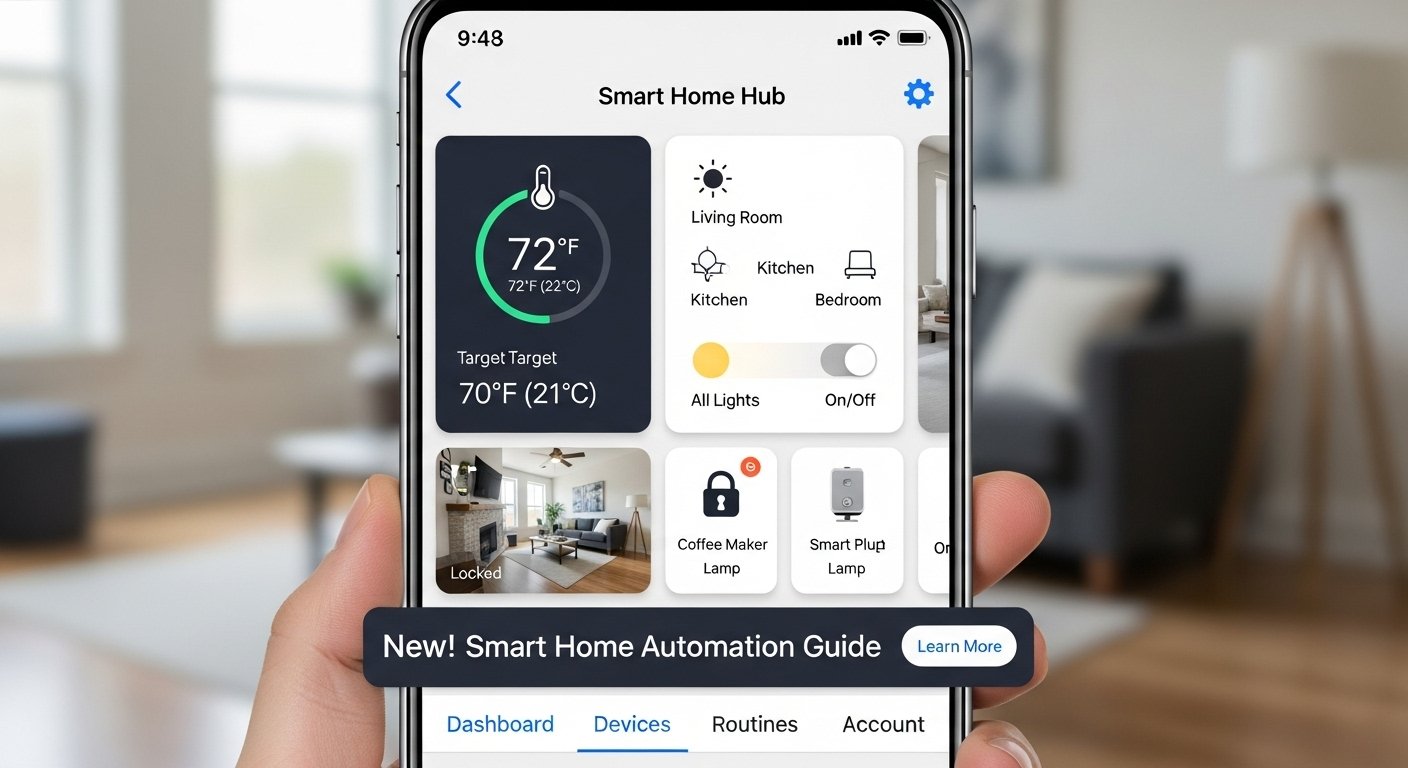
Unlocking Automation Routines and Scenes
The true magic of smart home technology lies in its ability to automate tasks. Automation routines and scenes allow your devices to perform actions automatically based on predefined conditions, transforming your smart home automation ideas into reality. This is where your home truly becomes ‘smart.’
Creating Basic Automations
Most smart home apps allow you to create simple automation routines. These are often based on ‘if this, then that’ logic:
- Time-Based Automations: “If it’s 6:00 AM, then turn on bedroom lights to 50% brightness.”
- Event-Based Automations: “If the front door opens, then turn on the entryway light.”
- Sensor-Based Automations: “If motion is detected in the living room, then turn on the living room lights.”
- Voice Command Triggers: “Alexa, good morning” – this could trigger your lights to come on, the thermostat to adjust, and the news to play.
These basic setups are excellent smart home automation ideas for beginners, providing immediate convenience and energy savings.
Advanced Automation Ideas and Scenes
As you gain confidence, you can explore more complex automations and ‘scenes.’ A scene is a preset combination of device states that can be activated with a single command or trigger.
- “Movie Night” Scene: Dim the living room lights, turn on the TV, and adjust the thermostat to a cozy temperature, all with one voice command.
- “Away” Routine: When you leave the house (triggered by geofencing or a button press), turn off all lights, arm the security system, and set the thermostat to an energy-saving temperature.
- “Wake Up” Routine: Gradually brighten bedroom lights, start the coffee maker (via a Smart Plug), and play gentle music.
- Adaptive Lighting: Use smart lighting automation to adjust the color temperature of your lights throughout the day, mimicking natural daylight for better well-being.
- Humidity Control: Pair a smart sensor with a smart plug connected to a dehumidifier to maintain optimal indoor humidity levels automatically.
Experimenting with automation routines and scenes is where your smart home truly begins to cater to your unique lifestyle, providing customized comfort and efficiency. It is important to note that Matter, the new smart home standard, aims to make creating such complex scenes even more straightforward across different brands. [25]
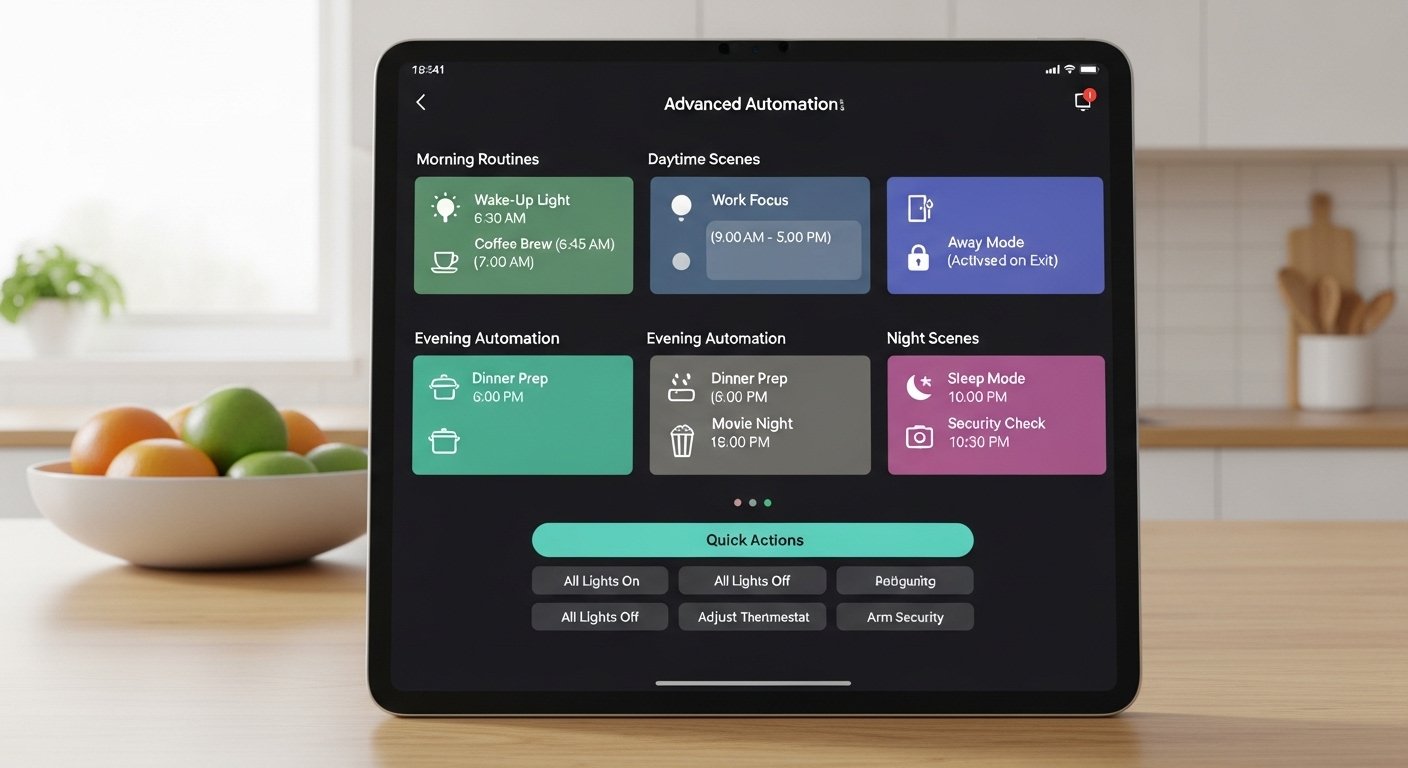
Prioritizing Security and Privacy in Your Smart Home
As you delve into the world of smart home technology, it’s crucial to consider the security and privacy implications. While smart devices offer immense convenience, ensuring your data and home are protected is paramount. This is a vital part of smart home security basics.
Here are a few tips for securing your smart home:
- Strong, Unique Passwords: Use complex, unique passwords for all your smart device accounts and your Wi-Fi network. Consider a password manager. [16, 24]
- Two-Factor Authentication (2FA): Enable 2FA wherever possible. This adds an extra layer of security, requiring a second verification step (like a code from your phone) in addition to your password. [16, 24]
- Keep Software Updated: Regularly update the firmware and software for all your smart devices and hubs. Manufacturers often release updates to patch security vulnerabilities. [16, 24, 34]
- Secure Your Wi-Fi Network: Use WPA3 encryption for your Wi-Fi (if your router supports it) and consider setting up a guest network for smart devices to isolate them from your main network. [16, 24, 34]
- Review Privacy Settings: Understand and review the privacy settings for each device and app. Limit data collection where possible and be mindful of what information you share. [24, 29]
- Disable Unused Features: If a device has features you don’t use (e.g., a microphone on a device without voice assistant capabilities), consider disabling them to reduce potential security risks.
- Research Device Security: Before purchasing, do a quick search on the manufacturer’s security practices and any reported vulnerabilities. Look for devices from reputable brands that prioritize security. For comprehensive tips on securing your smart home, consult guides from cybersecurity experts such as McAfee’s Smart Home Security Guide [24].
By following these home automation tips for beginners, you can enjoy the benefits of a smart home with greater peace of mind, knowing your digital life is protected.
Affordable Smart Home Solutions and Setup Costs
One common misconception is that building a smart home is prohibitively expensive. While high-end systems can be costly, there are plenty of affordable smart home solutions for beginners. The total smart home setup costs can vary significantly depending on your goals and the devices you choose. [17]
- Start Small: As recommended, begin with a few inexpensive devices like Smart Plugs (starting around $10-20 each) or a single Smart Lighting bulb ($15-30). A basic Smart Speaker can be acquired for $30-50.
- Utilize Sales and Bundles: Keep an eye out for sales events (like Black Friday or Amazon Prime Day) and starter bundles offered by manufacturers. These can provide significant savings.
- DIY Installation: Most beginner-friendly smart devices are designed for easy self-installation, saving you the cost of professional installers.
- Focus on Impact: Prioritize devices that offer the greatest impact on your daily life or energy savings, rather than buying every gadget available.
- Consider Brand Ecosystems: Sometimes, sticking within a single ecosystem (e.g., all Google Nest devices) can offer better bundle deals and seamless integration, potentially reducing overall costs.
Remember, your smart home journey is a marathon, not a sprint. You can build it gradually, spreading out the costs over time, making it accessible even on a student budget.
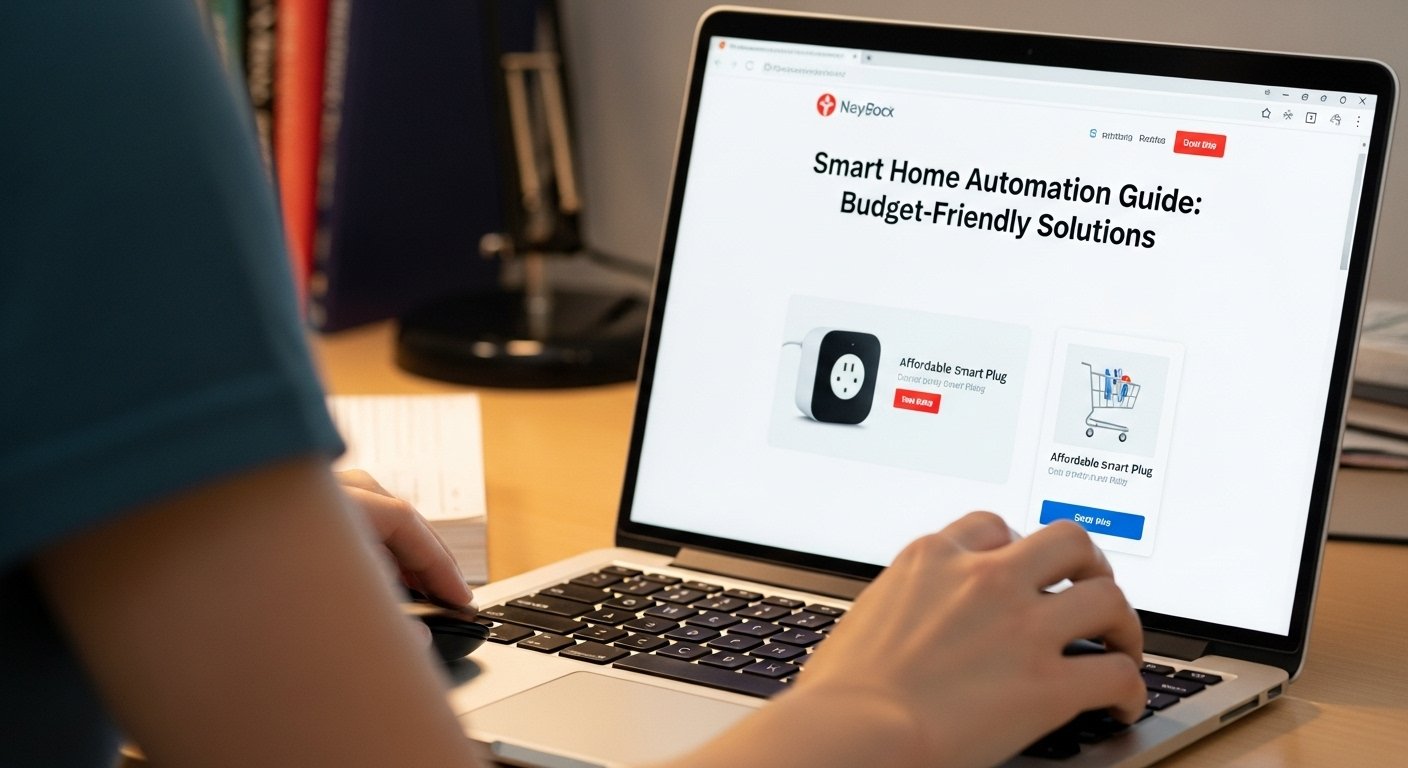
Tips for a Successful Smart Home Journey
To ensure a smooth and rewarding experience as you embark on your smart home adventure, consider these additional home automation tips for beginners:
- Plan Ahead: Even if starting small, have a general idea of your long-term smart home goals. This helps you choose devices that will be compatible as you expand.
- Read Reviews: Before purchasing, read reviews from other users. Pay attention to ease of installation, app reliability, and overall performance.
- Test and Adjust: Don’t be afraid to experiment with your automations. What sounds good on paper might need tweaking in practice. Adjust settings and routines until they work perfectly for you.
- Prioritize Wi-Fi Strength: A strong, reliable Wi-Fi network is the backbone of most smart homes. If you have dead zones, consider a mesh Wi-Fi system.
- Be Patient: Learning any new technology takes time. You might encounter small challenges, but with a bit of patience, you’ll master your smart home in no time.
- Stay Informed: The smart home market is constantly evolving. Stay updated on new devices, standards (like Matter), and security best practices to make the most of your setup.
By following these guidelines, your journey into smart home automation guide will be an enjoyable and rewarding one, transforming your living space into a truly intelligent and responsive environment.
Conclusion
Embarking on the journey of smart home automation is an exciting step towards a more convenient, secure, and energy-efficient lifestyle. From understanding what is a smart home to setting up your first Smart Plugs and creating custom automation routines and scenes, this guide has provided you with the foundational knowledge to begin. Remember to start small, choose an ecosystem that fits your needs, and prioritize security. With the global smart home market experiencing exponential growth, now is the perfect time for beginners to unlock the potential of a connected home. Welcome to smarter living!
Frequently Asked Questions
What is smart home automation?
Smart home automation refers to the process of making your home’s systems and devices (like lighting, heating, security, and entertainment) interconnected and controllable remotely or automatically. It enhances convenience, security, and energy efficiency by allowing these devices to communicate and respond to your commands or predefined schedules. [35]
How does smart home automation work?
Smart home automation works by connecting devices to a central network, often via Wi-Fi, Bluetooth, Zigbee, or Z-Wave, and sometimes managed by a Smart Hub. Users control these devices through smartphone apps, voice assistants (like Alexa or Google Assistant), or automated routines. Devices send and receive data, allowing them to respond to commands, sensors, or schedules to perform tasks automatically. [25, 35]
What devices are essential for a smart home for beginners?
For beginners, essential smart home devices typically include Smart Plugs (to make regular appliances smart), Smart Lighting (for easy control and ambiance), a Smart Thermostat (for energy savings), and a Smart Speaker/Voice Assistant (like an Amazon Echo or Google Nest Mini) for convenient voice control. These offer a great entry point into home automation. [37]
How do I set up a smart home system?
Setting up a smart home system generally involves: 1) Assessing your needs, 2) Choosing a compatible ecosystem (e.g., Amazon Alexa, Google Home), 3) Selecting essential devices, 4) Downloading the device’s app, 5) Pairing the device via the app, and 6) Naming and organizing it within your chosen ecosystem. Always follow the manufacturer’s specific instructions for each device.
What are the benefits of smart home automation?
The benefits of smart home automation are numerous, including enhanced convenience (remote control, voice commands), improved security (smart cameras, locks), significant energy savings (optimized lighting and heating), increased comfort, and even a potential increase in home resale value. 77% of consumers report positive impacts from their smart home devices. [12]
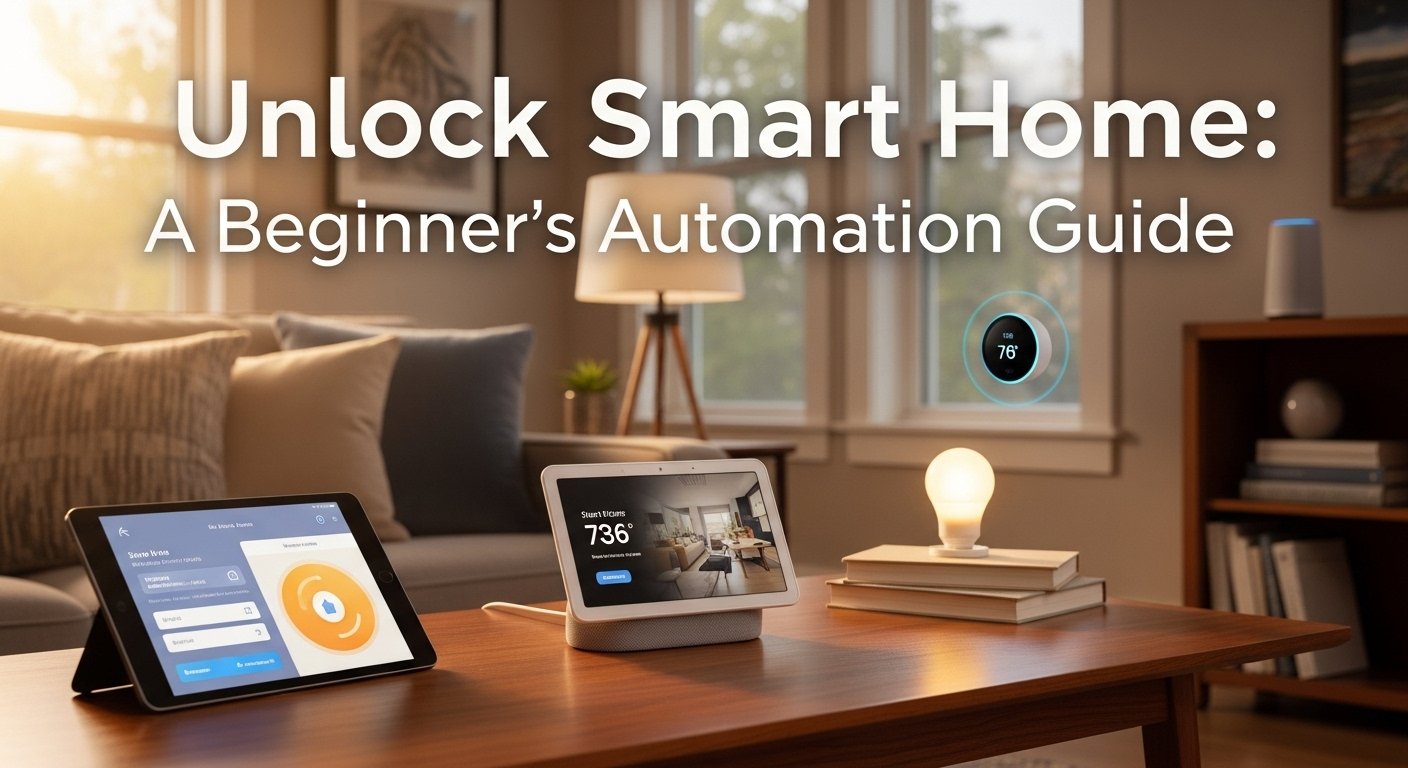
Leave a Reply